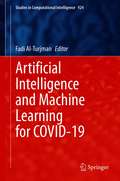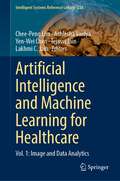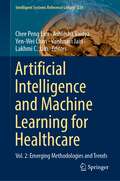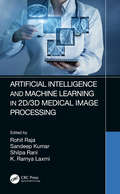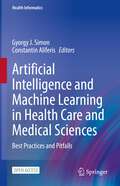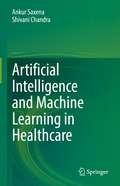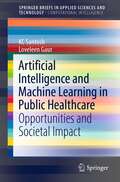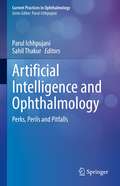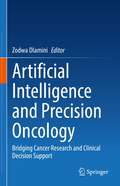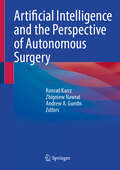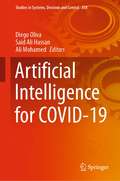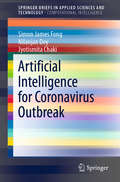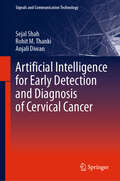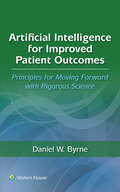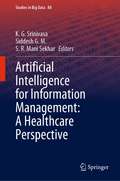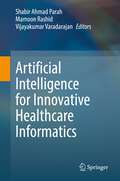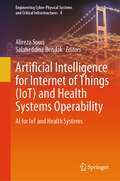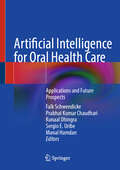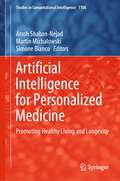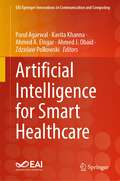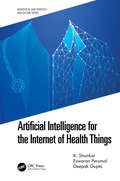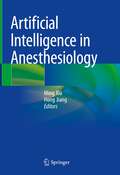- Table View
- List View
Artificial Intelligence and Machine Learning for COVID-19 (Studies in Computational Intelligence #924)
by Fadi Al-TurjmanThis book is dedicated to addressing the major challenges in fighting COVID-19 using artificial intelligence (AI) and machine learning (ML) – from cost and complexity to availability and accuracy. The aim of this book is to focus on both the design and implementation of AI-based approaches in proposed COVID-19 solutions that are enabled and supported by sensor networks, cloud computing, and 5G and beyond. This book presents research that contributes to the application of ML techniques to the problem of computer communication-assisted diagnosis of COVID-19 and similar diseases. The authors present the latest theoretical developments, real-world applications, and future perspectives on this topic. This book brings together a broad multidisciplinary community, aiming to integrate ideas, theories, models, and techniques from across different disciplines on intelligent solutions/systems, and to inform how cognitive systems in Next Generation Networks (NGN) should be designed, developed, and evaluated while exchanging and processing critical health information. Targeted readers are from varying disciplines who are interested in implementing the smart planet/environments vision via wireless/wired enabling technologies.
Artificial Intelligence and Machine Learning for Healthcare: Vol. 1: Image and Data Analytics (Intelligent Systems Reference Library #228)
by Lakhmi C. Jain Yen-Wei Chen Chee-Peng Lim Ashlesha Vaidya Tejasvi JainArtificial intelligence (AI) and machine learning (ML) have transformed many standard and conventional methods in undertaking health and well-being issues of humans. AL/ML-based systems and tools play a critical role in this digital and big data era to address a variety of medical and healthcare problems, improving treatments and quality of care for patients. This edition on AI and ML for healthcare consists of two volumes. The first presents selected AI and ML studies on medical imaging and healthcare data analytics, while the second unveils emerging methodologies and trends in AI and ML for delivering better medical treatments and healthcare services in the future.In this first volume, progresses in AI and ML technologies for medical image, video, and signal processing as well as health information and data analytics are presented. These selected studies offer readers theoretical and practical knowledge and ideas pertaining to recent advances in AI and ML for effective and efficient image and data analytics, leading to state-of-the-art AI and ML technologies for advancing the healthcare sector.
Artificial Intelligence and Machine Learning for Healthcare: Vol. 2: Emerging Methodologies and Trends (Intelligent Systems Reference Library #229)
by Lakhmi C. Jain Yen-Wei Chen Chee Peng Lim Ashlesha Vaidya Vaishnavi JainIn line with advances in digital and computing systems, artificial intelligence (AI) and machine learning (ML) technologies have transformed many aspects of medical and healthcare services, delivering tangible benefits to patents and the general public. This book is a sequel of the edition on “Artificial Intelligence and Machine Learning for Healthcare”. The first volume is focused on utilization of AI and ML for image and data analytics in the medical and healthcare domains. In this second volume, emerging methodologies and future trends in AI and ML for advancing medical treatments and healthcare services are presented. The selected studies in this book provide readers a glimpse on current progresses in AI and ML for undertaking a variety of healthcare-related tasks. The advances in AI and ML technologies for future healthcare are also discussed, shedding light on the potential of AI and ML to realize the next-generation medical treatments and healthcare services for the betterment of our global society.
Artificial Intelligence and Machine Learning in 2D/3D Medical Image Processing
by Sandeep Kumar Rohit Raja Shilpa Rani K. Ramya LaxmiDigital images have several benefits, such as faster and inexpensive processing cost, easy storage and communication, immediate quality assessment, multiple copying while preserving quality, swift and economical reproduction, and adaptable manipulation. Digital medical images play a vital role in everyday life. Medical imaging is the process of producing visible images of inner structures of the body for scientific and medical study and treatment as well as a view of the function of interior tissues. This process pursues disorder identification and management. Medical imaging in 2D and 3D includes many techniques and operations such as image gaining, storage, presentation, and communication. The 2D and 3D images can be processed in multiple dimensions. Depending on the requirement of a specific problem, one must identify various features of 2D or 3D images while applying suitable algorithms. These image processing techniques began in the 1960s and were used in such fields as space, clinical purposes, the arts, and television image improvement. In the 1970s, with the development of computer systems, the cost of image processing was reduced and processes became faster. In the 2000s, image processing became quicker, inexpensive, and simpler. In the 2020s, image processing has become a more accurate, more efficient, and self-learning technology. This book highlights the framework of the robust and novel methods for medical image processing techniques in 2D and 3D. The chapters explore existing and emerging image challenges and opportunities in the medical field using various medical image processing techniques. The book discusses real-time applications for artificial intelligence and machine learning in medical image processing. The authors also discuss implementation strategies and future research directions for the design and application requirements of these systems. This book will benefit researchers in the medical image processing field as well as those looking to promote the mutual understanding of researchers within different disciplines that incorporate AI and machine learning. FEATURES Highlights the framework of robust and novel methods for medical image processing techniques Discusses implementation strategies and future research directions for the design and application requirements of medical imaging Examines real-time application needs Explores existing and emerging image challenges and opportunities in the medical field
Artificial Intelligence and Machine Learning in Health Care and Medical Sciences: Best Practices and Pitfalls (Health Informatics)
by Constantin Aliferis Gyorgy J. SimonThis open access book provides a detailed review of the latest methods and applications of artificial intelligence (AI) and machine learning (ML) in medicine. With chapters focusing on enabling the reader to develop a thorough understanding of the key concepts in these subject areas along with a range of methods and resulting models that can be utilized to solve healthcare problems, the use of causal and predictive models are comprehensively discussed. Care is taken to systematically describe the concepts to facilitate the reader in developing a thorough conceptual understanding of how different methods and resulting models function and how these relate to their applicability to various issues in health care and medical sciences. Guidance is also given on how to avoid pitfalls that can be encountered on a day-to-day basis and stratify potential clinical risks. Artificial Intelligence and Machine Learning in Health Care and Medical Sciences: Best Practices and Pitfallsis a comprehensive guide to how AI and ML techniques can best be applied in health care. The emphasis placed on how to avoid a variety of pitfalls that can be encountered makes it an indispensable guide for all medical informatics professionals and physicians who utilize these methodologies on a day-to-day basis. Furthermore, this work will be of significant interest to health data scientists, administrators and to students in the health sciences seeking an up-to-date resource on the topic.
Artificial Intelligence and Machine Learning in Healthcare
by Ankur Saxena Shivani ChandraThis book reviews the application of artificial intelligence and machine learning in healthcare. It discusses integrating the principles of computer science, life science, and statistics incorporated into statistical models using existing data, discovering patterns in data to extract the information, and predicting the changes and diseases based on this data and models. The initial chapters of the book cover the practical applications of artificial intelligence for disease prognosis & management. Further, the role of artificial intelligence and machine learning is discussed with reference to specific diseases like diabetes mellitus, cancer, mycobacterium tuberculosis, and Covid-19. The chapters provide working examples on how different types of healthcare data can be used to develop models and predict diseases using machine learning and artificial intelligence. The book also touches upon precision medicine, personalized medicine, and transfer learning, with the real examples. Further, it also discusses the use of machine learning and artificial intelligence for visualization, prediction, detection, and diagnosis of Covid -19. This book is a valuable source of information for programmers, healthcare professionals, and researchers interested in understanding the applications of artificial intelligence and machine learning in healthcare.
Artificial Intelligence and Machine Learning in Public Healthcare: Opportunities and Societal Impact (SpringerBriefs in Applied Sciences and Technology)
by Loveleen Gaur KC SantoshThis book discusses and evaluates AI and machine learning (ML) algorithms in dealing with challenges that are primarily related to public health. It also helps find ways in which we can measure possible consequences and societal impacts by taking the following factors into account: open public health issues and common AI solutions (with multiple case studies, such as TB and SARS: COVID-19), AI in sustainable health care, AI in precision medicine and data privacy issues. Public health requires special attention as it drives economy and education system. COVID-19 is an example—a truly infectious disease outbreak. The vision of WHO is to create public health services that can deal with abovementioned crucial challenges by focusing on the following elements: health protection, disease prevention and health promotion. For these issues, in the big data analytics era, AI and ML tools/techniques have potential to improve public health (e.g., existing healthcare solutions and wellness services). In other words, they have proved to be valuable tools not only to analyze/diagnose pathology but also to accelerate decision-making procedure especially when we consider resource-constrained regions.
Artificial Intelligence and Ophthalmology: Perks, Perils and Pitfalls (Current Practices in Ophthalmology)
by Parul Ichhpujani Sahil ThakurThe book helps to explore the vast expanse of artificial intelligence-based scientific content that has been published in the last few years. Ophthalmology has recently undergone a silent digital revolution, with machine learning and deep learning algorithms consistently outperforming human graders in studies published across the globe. It is high time that a resource that breaks this information behemoth into easily digestible bits comes to the fore. This book simplifies the complex mechanics of algorithms used in ophthalmology and vision science applications. It also tries to address potential ethical issues with machines entering our clinics and patients’ lives. Overall it is essential reading for ophthalmologists/eye care professionals interested in artificial intelligence and everyone who is looking for a deep dive into the exciting world of digital medicine.
Artificial Intelligence and Precision Oncology: Bridging Cancer Research and Clinical Decision Support
by Zodwa DlaminiThis book highlights the use of artificial intelligence (AI), big data and precision oncology for medical decision making in cancer screening, diagnosis, prognosis and treatment. Precision oncology has long been thought of as ideal for the management and treatment of cancer. This strategy promises to revolutionize the treatment, control, and prevention of cancer by tailoring tests, treatments and predictions to specific individuals or population groups. In order to accomplish these goals, vast amounts of patient or population group specific data needs to be integrated and analysed to be able to identify key patterns or features which can be used to define or characterize the disease or the response to the disease in these individuals. These patterns or features can be as varied as molecular patterns or features in medical images. This level of data analysis and integration can only be achieved through the use of AI. The book is divided into three parts starting with a section on the use of artificial intelligence for screening, diagnosis and monitoring in precision oncology. The second part: Artificial intelligence and Omics in precision oncology, highlights the use of AI and epigenetics, metabolomics, microbiomics in precision oncology. The third part covers artificial intelligence in cancer therapy and its clinical applications. It also highlights the use of AI tools for risk prediction, early detection, diagnosis and accurate prognosis. This book, written by experts in the field from academia and industry, will appeal to cancer researchers, clinical oncologists, pathologists, medical students, academic teaching staff and medical residents interested in cancer research as well as those specialising as clinical oncologists.
Artificial Intelligence and the Perspective of Autonomous Surgery
by Konrad Karcz Zbigniew Nawrat Andrew A. GumbsThis book has two heroes - the surgeon and the robot. The education system and intelligence can create a human who is specialized in surgery. While the accurate analysis of data with machine learning, AI, can create a more autonomous robot for surgery. Currently, robots still require human input in the decision-making loop, whether or not this will always be the case is an issue that still needs to be debated, analyzed and studied, preferably by computer scientists AND surgeons. Surgeons and their patients are increasingly opting for less invasive surgeries. However, among their many advantages, there is an important issue: less invasiveness always means limited access to direct information from the operating field (3D image, local palpation sensations, all information about the "whole" patient and feedback from the accompanying team during teleoperation). To increase precision, we are increasingly using surgical robots and mechatronic instruments. The less invasive the surgery and the greater the precision of robotic micro-instruments, the greater the role of artificial intelligence methods, especially machine learning, which supports the surgeon in making decisions, planning and performing the procedure. The development of artificial intelligence and further evidence of its effectiveness in various application fields mean that the work of a doctor is changing today. In the book, we address the issue of AI surgery, asking whether this means that an AI surgeon will be created? A key question about autonomous surgical robots will come up regularly: how far can we go with their autonomy while maintaining safe and effective procedures? The book provides useful information on both early successes, failures, and expectations related to the development of new technologies in surgery. It is a guide written by various experts, intended for a wide audience: from medical development planners, through students, to doctors and decision-makers.
Artificial Intelligence for COVID-19 (Studies in Systems, Decision and Control #358)
by Diego Oliva Said Ali Hassan Ali MohamedThis book presents a compilation of the most recent implementation of artificial intelligence methods for solving different problems generated by the COVID-19. The problems addressed came from different fields and not only from medicine. The information contained in the book explores different areas of machine and deep learning, advanced image processing, computational intelligence, IoT, robotics and automation, optimization, mathematical modeling, neural networks, information technology, big data, data processing, data mining, and likewise. Moreover, the chapters include the theory and methodologies used to provide an overview of applying these tools to the useful contribution to help to face the emerging disaster. The book is primarily intended for researchers, decision makers, practitioners, and readers interested in these subject matters. The book is useful also as rich case studies and project proposals for postgraduate courses in those specializations.
Artificial Intelligence for Coronavirus Outbreak (SpringerBriefs in Applied Sciences and Technology)
by Nilanjan Dey Jyotismita Chaki Simon James FongThis book examines how the wonders of AI have contributed to the battle against COVID-19. Just as history repeats itself, so do epidemics and pandemics. In the face of the novel coronavirus disease, COVID-19, the book explores whether, in this digital era where artificial intelligence is successfully applied in all areas of industry, we are doing any better than our ancestors did in dealing with pandemics. One of the most contagious diseases ever known, COVID-19 is spreading like wildfire around and has cost thousands of human lives.The book discusses how AI can help fight this deadly virus, from early warnings, prompt emergency responses, and critical decision-making to surveillance drones. Serving as a technical reference resource, data analytic tutorial and a chronicle of the application of AI in epidemics, this book will appeal to academics, students, data scientists, medical practitioners, and anybody who is concerned about this global epidemic.
Artificial Intelligence for Early Detection and Diagnosis of Cervical Cancer (Signals and Communication Technology)
by Rohit M. Thanki Sejal Shah Anjali DiwanThis book introduces the revolutionary use of AI in the field of cervical cancer detection. The book explores how advanced computer algorithms can analyze medical images and patient data to enhance early detection and accurate diagnosis of cervical cancer. The book starts by providing a comprehensive overview of cervical cancer, its risk factors, and the importance of early detection. It then delves into the fundamental concepts of artificial intelligence and its application in healthcare. Readers will gain a deeper understanding of how AI algorithms can "see" patterns in cervical cells and tissue, enabling the detection of abnormal cells and precancerous changes that may indicate the presence of cervical cancer. Drawing on the latest research and real-world case studies, the book showcases the various AI techniques used for cervical cancer screening, including the analysis of Pap smear and liquid-based cytology images. This book is an essential read for healthcare professionals, researchers, policymakers, and anyone interested in the intersection of AI and healthcare.
Artificial Intelligence for Health 4.0: Challenges and Applications
by Naveen Chilamkurti Balamurugan Balusamy Rajesh Kumar Dhanaraj Rishabha Malviya Sonali SundramHealthcare is one of the major success stories of our times. Medical science has improved rapidly, raising life expectancy around the world. However, as longevity increases, healthcare systems face growing demands for their services, rising costs, and a workforce that is struggling to meet the needs of its patients. Healthcare is one of the most critical sectors in the broader landscape of big data because of its fundamental role in a productive, thriving society. Building on automation, artificial intelligence (AI) has the potential to revolutionize healthcare and help address some of the challenges set out above. The application of AI to healthcare data can literally be a matter of life and death. AI can assist doctors, nurses, and other healthcare workers in their daily work. AI in healthcare can enhance preventive care and quality of life, produce more accurate diagnoses and treatment plans, and lead to better patient outcomes overall. This book gives insights into the latest developments of applications of AI in biomedicine, including disease diagnostics, pharmaceutical processing, patient care and monitoring, biomedical information, and biomedical research. It also presents an outline of the recent breakthroughs in the application of AI in healthcare, describes a roadmap to building effective, reliable, and safe AI systems, and discusses the possible future direction of AI augmented healthcare systems. AI has countless applications in healthcare. Whether it’s being used to discover links between genetic codes, to power surgical robots or even to maximize hospital efficiency; AI has been a boon to the healthcare industry.
Artificial Intelligence for Healthy Longevity (Healthy Ageing and Longevity #19)
by Alexey Moskalev Ilia Stambler Alex ZhavoronkovThis book reviews the state-of-the-art efforts to apply machine learning and AI methods for healthy aging and longevity research, diagnosis, and therapy development. The book examines the methods of machine learning and their application in the analysis of big medical data, medical images, the creation of algorithms for assessing biological age, and effectiveness of geroprotective medications.The promises and challenges of using AI to help achieve healthy longevity for the population are manifold. This volume, written by world-leading experts working at the intersection of AI and aging, provides a unique synergy of these two highly prominent fields and aims to create a balanced and comprehensive overview of the application methodology that can help achieve healthy longevity for the population.The book is accessible and valuable for specialists in AI and longevity research, as well as a wide readership, including gerontologists, geriatricians, medical specialists, and students from diverse fields, basic scientists, public and private research entities, and policy makers interested in potential intervention in degenerative aging processes using advanced computational tools.
Artificial Intelligence for Improved Patient Outcomes: Principles for Moving Forward with Rigorous Science
by Daniel W. ByrneArtificial Intelligence for Improved Patient Outcomes provides new, relevant, and practical information on what AI can do in healthcare and how to assess whether AI is improving health outcomes. With clear insights and a balanced approach, this innovative book offers a one-stop guide on how to design and lead pragmatic real-world AI studies that yield rigorous scientific evidence—all in a manner that is safe and ethical. Daniel Byrne, Director of Artificial Intelligence Research at AVAIL (the Advanced Vanderbilt Artificial Intelligence Laboratory) and author of landmark pragmatic studies published in leading medical journals, shares four decades of experience as a biostatistician and AI researcher. Building on his first book, Publishing Your Medical Research, the author gives the reader the competitive advantage in creating reproducible AI research that will be accepted in prestigious high-impact medical journals.
Artificial Intelligence for Information Management: A Healthcare Perspective (Studies in Big Data #88)
by K. G. Srinivasa Siddesh G. M. S. R. Mani SekharThis book discusses the advancements in artificial intelligent techniques used in the well-being of human healthcare. It details the techniques used in collection, storage and analysis of data and their usage in different healthcare solutions. It also discusses the techniques of predictive analysis in early diagnosis of critical diseases. The edited book is divided into four parts – part A discusses introduction to artificial intelligence and machine learning in healthcare; part B highlights different analytical techniques used in healthcare; part C provides various security and privacy mechanisms used in healthcare; and finally, part D exemplifies different tools used in visualization and data analytics.
Artificial Intelligence for Innovative Healthcare Informatics
by Shabir Ahmad Parah Mamoon Rashid Vijayakumar VaradarajanThere are several popular books published in Healthcare Computational Informatics like Computational Bioengineering and Bioinformatics (2020), Springer; Health Informatics (2017), Springer; Health Informatics Vision: From Data via Information to Knowledge (2019), IOS Press; Data Analytics in Biomedical Engineering and Healthcare (2020), Elsevier. However, in all these mentioned books, the challenges in Biomedical Imaging are solved in one dimension by use of any specific technology like Image Processing, Machine Learning or Computer Aided Systems. In this book, the book it has been attempted to bring all technologies related to computational analytics together and apply them on Biomedical Imaging.
Artificial Intelligence for Internet of Things: AI for IoT and Health Systems (Engineering Cyber-Physical Systems and Critical Infrastructures #8)
by Alireza Souri Salaheddine BendakIoTHIC-2023 is a multidisciplinary, peer-reviewed international conference on Internet of Things (IoT) and healthcare systems with Artificial Intelligence (AI) techniques such as data mining, machine learning, image processing, and meta-heuristic algorithms. The AI-based techniques are applied on many fields of healthcare systems, including predicting and detecting diseases in hospitals, clinics, smart health monitoring systems, surgery, medical services, and etc.
Artificial Intelligence for Oral Health Care: Applications and Future Prospects
by Falk Schwendicke Prabhat Kumar Chaudhari Kunaal Dhingra Sergio E. Uribe Manal HamdanArtificial intelligence (AI) is reshaping diagnostics, treatment planning, and patient care across diverse disciplines. Dentistry is now at the forefront of this innovation, with AI's ability to process complex data to improve clinical practice, empower patients, and address public health challenges. This richly illustrated book offers a deeper understanding of the foundational concepts of AI, its practical applications in oral health, and the possibilities that lie ahead. From oral pathology to maxillofacial surgery, prosthodontics to orthodontics, and endodontics to dental education, it presents compelling, evidence-based insights into how AI is changing the landscape of dentistry. Beyond its clinical potential, the book tackles the key risks and challenges associated with AI implementation. It provides a thoughtful roadmap for addressing ethical considerations, encouraging transparency, and developing solutions that prioritize both innovation and patient well-being. Written for dental professionals and an interdisciplinary audience, including educators, researchers, policymakers, and the public, this book serves as both a guide and a call to action for responsibly embracing AI's transformative power. Whether you are a seasoned practitioner, an academic, or simply curious about the intersection of AI and healthcare, this book will inspire and inform your journey into the future of dentistry.
Artificial Intelligence for Personalized Medicine: Promoting Healthy Living and Longevity (Studies in Computational Intelligence #1106)
by Simone Bianco Arash Shaban-Nejad Martin MichalowskiThis book aims to highlight the latest achievements in the use of AI in personalized medicine and healthcare delivery. The edited book contains selected papers presented at the 2023 Health Intelligence workshop, co-located with the Thirty-Seven Association for the Advancement of Artificial Intelligence (AAAI) conference, and presents an overview of the issues, challenges, and potentials in the field, along with new research results. This book provides information for researchers, students, industry professionals, clinicians, and public health agencies interested in the applications of AI in medicine and public health.
Artificial Intelligence for Smart Healthcare (EAI/Springer Innovations in Communication and Computing)
by Zdzislaw Polkowski Ahmed A. Elngar Ahmed J. Obaid Parul Agarwal Kavita KhannaThis book provides information on interdependencies of medicine and telecommunications engineering and how the two must rely on each other to effectively function in this era. The book discusses new techniques for medical service improvisation such as clear-cut views on medical technologies. The authors provide chapters on communication essentiality in healthcare, processing of medical amenities using medical images, the importance of data and information technology in medicine, and machine learning and artificial intelligence in healthcare. Authors include researchers, academics, and professionals in the field.
Artificial Intelligence for the Internet of Health Things (Biomedical and Robotics Healthcare)
by Deepak Gupta K. Shankar Eswaran PerumalThis book discusses research in Artificial Intelligence for the Internet of Health Things. It investigates and explores the possible applications of machine learning, deep learning, soft computing, and evolutionary computing techniques in design, implementation, and optimization of challenging healthcare solutions. This book features a wide range of topics such as AI techniques, IoT, cloud, wearables, and secured data transmission. Written for a broad audience, this book will be useful for clinicians, health professionals, engineers, technology developers, IT consultants, researchers, and students interested in the AI-based healthcare applications. Provides a deeper understanding of key AI algorithms and their use and implementation within the wider healthcare sector Explores different disease diagnosis models using machine learning, deep learning, healthcare data analysis, including machine learning, and data mining and soft computing algorithms Discusses detailed IoT, wearables, and cloud-based disease diagnosis model for intelligent systems and healthcare Reviews different applications and challenges across the design, implementation, and management of intelligent systems and healthcare data networks Introduces a new applications and case studies across all areas of AI in healthcare data K. Shankar (Member, IEEE) is a Postdoctoral Fellow of the Department of Computer Applications, Alagappa University, Karaikudi, India. Eswaran Perumal is an Assistant Professor of the Department of Computer Applications, Alagappa University, Karaikudi, India. Dr. Deepak Gupta is an Assistant Professor of the Department Computer Science & Engineering, Maharaja Agrasen Institute of Technology (GGSIPU), Delhi, India.
Artificial Intelligence in Anesthesiology
by Hong Jiang Ming XiaConsidering the rapid developments in digital and information technologies, artificial intelligence has long been a hot topic in medicine. This book discusses applications of artificial intelligence in anaesthesiology, including control of anesthesia, risk prediction, ultrasound guidance, pain management, and operating room logistics. This book first defines basic concepts of AI, and give a brief overview of a few algorithms frequently used in AI and machine learning. A review of current AI and machine learning applications for the prediction of anesthesia conditions is also discussed, including those for the prediction of difficult airways before surgery, of adverse events and sedation effects during surgery, and of vomiting and pain after surgery. Even without extensive promotion and clinical application, AI is in development in anesthesiology; furthermore, it has a great deal of potential to maintain further development in the future. Lastly, ethical and safety considerations are discussed alongside AI limitations and challenges in anesthesiology.
Artificial Intelligence in Biobanking: Ethical, Legal and Societal Challenges
by Santa Slokenberga Michaela Th. Mayrhofer Signe MežinskaThis insightful collection highlights the ethical, legal and societal issues associated with the increasing role played by artificial intelligence (AI) in medical biobanks, a key research resource in the global study of disease prevention and improving individual care.Although AI has the potential to speed up health research, the book considers numerous questions that the technology poses, from the building of trust to the prevention of harm to individuals, vulnerable groups or entire populations. Examining the tension between scientific progress and safeguarding of individual rights, and covering key issues such as accountability, data bias, transparency, and liability, the book considers the legal landscape in which biobanks operate, and what layers of governance are required to oversee such an important resource in a fluid technological age.A timely volume that brings together scholars and experts from social sciences, ethics, and law, this important book will interest researchers and professionals in Biomedicine, Law, and the broader Health Sciences.The Open Access version of this book, available at http://www.taylorfrancis.com, has been made available under a Creative Commons Attribution CC BY 4.0 license.
